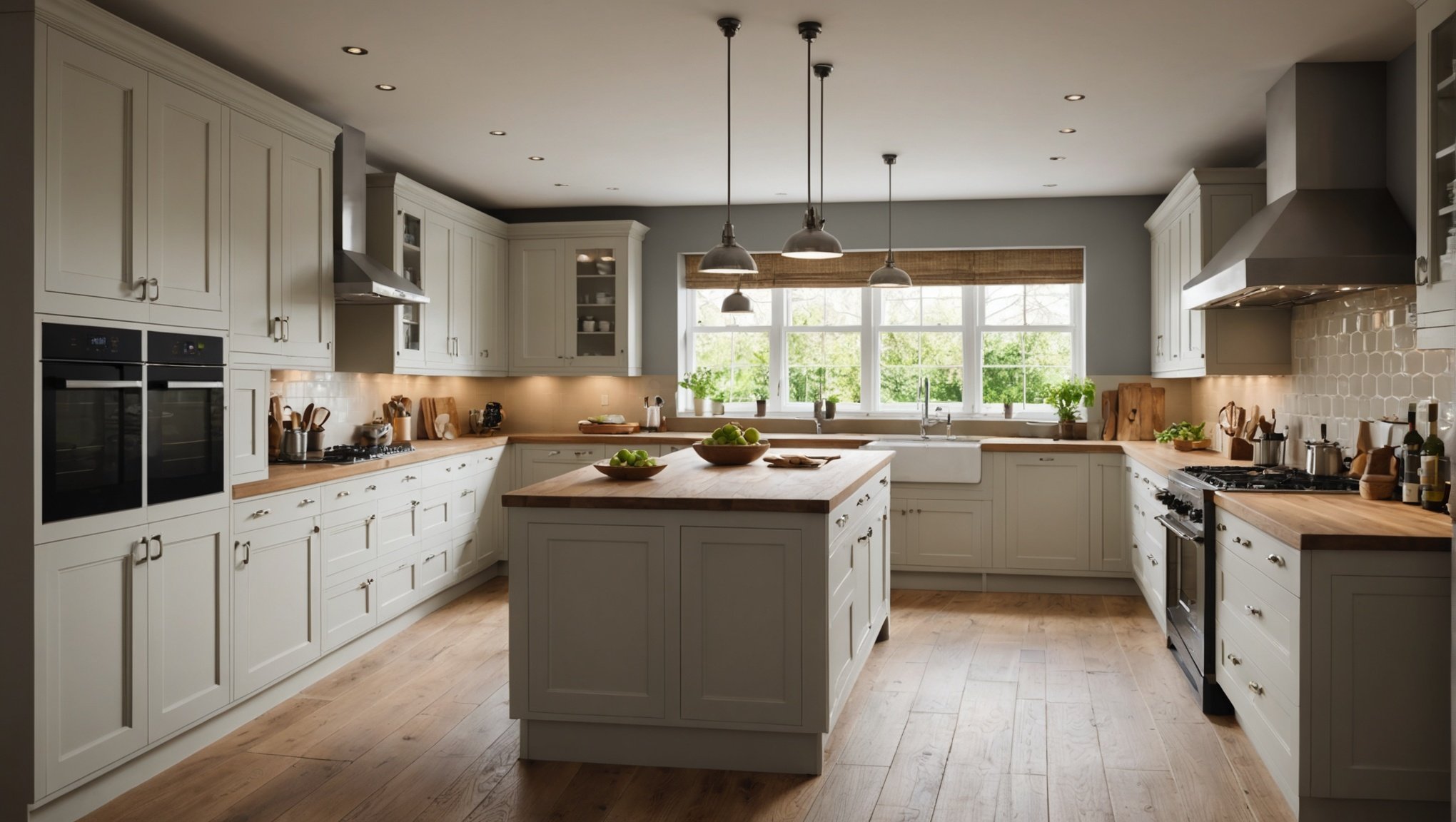Transform Your UK Kitchen: A Guide to Selecting the Perfect Lighting Fixtures for a Warm and Inviting Atmosphere
When it comes to designing or remodeling your kitchen, one of the most critical elements to consider is the lighting. The right lighting can transform your kitchen from a mere cooking space into a warm, inviting, and multifunctional hub of your home. Here’s a comprehensive guide to help you select the perfect lighting fixtures for your UK kitchen.
Understanding the Different Types of Lighting
To create a well-lit and inviting kitchen, you need to understand the three primary types of lighting: task lighting, ambient lighting, and accent lighting.
Additional reading : Smart Guide to Selecting an Energy-Efficient Microwave for Your UK Home
Task Lighting
Task lighting is designed to illuminate specific areas where you perform tasks such as cooking, preparing meals, and cleaning. This type of lighting is crucial for safety and efficiency.
- LED Lighting and Spotlights: Ideal for bright overhead lighting, LED lights and spotlights are perfect for task areas like countertops and the hob. They provide focused light exactly where you need it, reducing shadows and improving visibility.
- Under-Cabinet Lighting: This type of lighting is great for illuminating work surfaces and reducing shadows. It can be especially useful in kitchens with limited natural light.
Ambient Lighting
Ambient lighting sets the overall mood and atmosphere of your kitchen. It provides general illumination and can make the space feel more welcoming.
In parallel : Selecting the Best Kitchen Tiles for Maximum Durability in UK Weather: A Comprehensive Guide
- Pendant Lights and Chandeliers: These fixtures can add drama and visual intrigue to your kitchen. For standard ceilings, pendants should hang around 30 to 36 inches above the worksurface. They are particularly effective over kitchen islands or dining tables.
- Flush or Semi-Flush Mounts: These lights are versatile and can be used to create a mix of cool and warm tone lighting, depending on the type of lightbulbs you choose.
Accent Lighting
Accent lighting highlights specific features or areas of your kitchen, adding depth and visual interest.
- Wall Lights: Adjustable wall lights can illuminate decorative elements, such as kitchen units or shelves, drawing the eye to these areas.
- Back Panel Lighting: LED back panel lighting kits can be used with glass-fronted units to create a dramatic and modern look. This type of lighting is energy-efficient and requires minimal maintenance.
Planning Your Lighting Scheme
Before you start selecting light fixtures, it’s essential to plan your lighting scheme carefully.
Consider Your Kitchen Layout
Your kitchen lighting should be designed to dovetail with your kitchen layout. This includes understanding the different tasks and functions you will perform in each area.
- Visualize Your Space: Picture yourself cooking, working, eating, and socializing in your kitchen. Think about how you want the space to feel during different times of the day and for various activities. This will help you determine where you need light to fall rather than just where to install the lights.
- Avoid Grid Formats: Steer clear of using a grid format for your ceiling downlights. Instead, place lights where they are needed most, such as over worktops, the hob, or the dining table. A grid format can lead to shadows over working areas or lights being too close to cupboards.
Layered Lighting
A layered lighting approach combines task, ambient, and accent lighting to create a versatile and inviting atmosphere.
- Symmetrical Wall Lighting: Use symmetrical wall lighting, elegant table lamps, and pendants or chandeliers to create little pockets and pools of light. This approach provides flexibility depending on the mood you want to create and can be enhanced with dimmers.
- Mix Up Your Lights: Combine different types of lights to achieve a balanced look. For example, use downlights for functional lighting, pendants for ambient lighting, and spotlights for task lighting.
Choosing the Right Light Fixtures
Selecting the right light fixtures can make a significant difference in the overall look and feel of your kitchen.
Pendant Lights
Pendant lights are a popular choice for kitchens and can be used to create a statement piece.
- Size and Positioning: Ensure that the total width of the pendants is about two-thirds to three-quarters of the island’s width. For standard ceilings, pendants should hang around 30 to 36 inches above the worksurface.
- Style and Material: In 2024, geometric and sculptural lighting fixtures are in style, along with metallic finishes in matte black or brass. These can add a modern and sleek look to your kitchen.
Smart Lighting Solutions
Smart lighting solutions are becoming increasingly popular, especially in modern kitchen designs.
- Dimmer Switches: Using dimmer switches allows you to adjust the brightness according to different activities and moods. This is crucial for creating a flexible lighting scheme that can adapt to various needs, from meal preparation to dining or entertaining.
- App-Controlled Lights: Smart lighting systems that can be controlled via apps offer the convenience of adjusting lighting settings remotely. These systems can also change the color temperature and brightness to fit various activities and moods.
Maximizing Natural Light
Natural light is essential for creating a bright and airy feel in your kitchen.
Large Windows and Skylights
- Open-Plan Layouts: Large windows, skylights, and open-plan layouts can help maximize natural light, making the kitchen feel more spacious and bright.
- Reflective Surfaces: Use reflective surfaces like glass splashbacks or shiny cabinets to bounce light around the space, further enhancing the feeling of openness.
Practical Tips and Considerations
Here are some practical tips to keep in mind when designing your kitchen lighting scheme:
Energy Efficiency
- LED Lighting: LED lights are energy-efficient, emit low heat, and require minimal maintenance. They are ideal for areas that are hard to reach or require little upkeep.
Lighting Temperature
- Warm vs. Cool Light: Choose the right temperature of light based on the function of your space. Warm light (3000K or lower) is more yellow and cozy, while cool light (4000K or above) is more blue and bright. A middle ground of 3500K can offer a neutral look that adapts to different decor and lighting.
Budget-Friendly Options
- Lamps: Adding lamps, such as table lamps or floor lamps, can be a budget-friendly way to enhance your kitchen lighting. These can add focused lighting and a decorative element to your space.
Detailed Checklist for Your Kitchen Lighting
Here is a detailed checklist to help you plan and execute your kitchen lighting scheme:
- Task Lighting:
- LED lights or spotlights for worktops and the hob
- Under-cabinet lighting for reducing shadows
- Cabinet lighting for illuminating inside cabinets
- Ambient Lighting:
- Pendant lights or chandeliers for general illumination
- Flush or semi-flush mounts for a mix of cool and warm tone lighting
- Dimmer switches for adjusting brightness
- Accent Lighting:
- Wall lights to highlight decorative elements
- Back panel lighting for glass-fronted units
- Spotlights to highlight specific areas
- Natural Light:
- Large windows and skylights
- Open-plan layouts
- Reflective surfaces like glass splashbacks or shiny cabinets
- Smart Lighting Solutions:
- Dimmer switches
- App-controlled lights
- Tunable lights for changing color temperatures
Table: Comparing Different Lighting Options
| Lighting Type | Description | Best Use | Energy Efficiency | Style Options |
|---|---|---|---|---|
| LED Lights | Bright, focused light | Task lighting | High energy efficiency | Various styles, including spotlights and under-cabinet lights |
| Pendant Lights | General illumination, decorative | Ambient lighting | Varies depending on bulb | Geometric, sculptural, metallic finishes |
| Wall Lights | Highlight decorative elements | Accent lighting | Moderate energy efficiency | Adjustable, antiqued brass, modern designs |
| Smart Lights | Adjustable brightness and color temperature | Ambient and task lighting | High energy efficiency | App-controlled, tunable lights |
| Skylights | Natural light | Natural light | High energy efficiency | Fixed installations, various sizes |
| Dimmer Switches | Adjustable brightness | All types of lighting | Varies depending on bulb | Essential for flexible lighting schemes |
Quotes from Experts
- “Few kitchens nowadays are merely working spaces. They’re usually multi-functional and act as the hub of the home, so getting the lighting right in this area is vital,” says Claire Pendarves, a lighting expert.
- “Always avoid a rectangular grid distributed evenly across your space. It’s an easy thing to draw on a plan but it’s about the worst thing you can do,” advises Melanie Shaw, design director at Brilliant Lighting.
- “Lighting is a key component because it sets the mood and can make a dramatic impact on the ambience of your space as it illuminates both your cooking and entertainment areas,” says Jen Nash, head of design at Magnet.
Designing the perfect lighting scheme for your kitchen is a multifaceted task that requires careful planning and consideration. By understanding the different types of lighting, planning your layout, choosing the right fixtures, and maximizing natural light, you can create a warm, inviting, and highly functional space that serves as the heart of your home. Remember to layer your lighting, consider energy efficiency, and don’t forget the importance of dimmer switches and smart lighting solutions. With these tips and insights, you’ll be well on your way to transforming your UK kitchen into a space that is both beautiful and practical.






